2011 Yamaha Snowmobile Lineup Preview

Vastly improved Apex series comes in three easy-steering flavors
Based on a test ride of the disguised pre-production 2011 Apex models that we test rode in early January, we can state that we got some things right, some kind of right and some wretchedly wrong!
The wretchedly wrong comes from our thinking that Yamaha might totally eliminate the entire Apex series in favor of some triple-cylinder, groomed trail-oriented Nytro hybrid. We were wrong as could be. Not only is Yamaha not tossing in the towel on its four-cylinder high-performance trail sled, but rather the Japanese-based powersports manufacturer is committing to it long term.
We all know that the Apex has been the forgotten model for the past few seasons as Yamaha focused on its rough trail and deep snow models. An entirely new chassis and engine were developed for the mogul and powder set. A version of the all-new, fuel injected, three-cylinder Nytro motor found its way into the sport performance Vector series. Some attention went to the trail models — Apex and Vector — in the manner of revised front and rear suspensions, but nothing as major as the attention turned on the hot rod Nytro and mountain versions.
Chasing Sales
This was understandable as the mountain segment has been a consistent sales performer for the past decade and Yamaha sought to win over the steep and deep clan to four-stroke power with long-tracked Nytro and Apex mountain sleds. Yamaha’s entrance into sncross racing hinted of a new rough trail hot rod with a snocross background. That has become the Nytro series and it appeals to the big bump rider. But, the tried and true trail rider seemed to be forgotten.
The Vector and Apex worked just fine, but there wasn’t anything to get jacked up about. With its Deltabox front end and mono-shock rear suspension, these trail models worked very well. A revised front suspension helped give them improved steering and the remote dial adjustment on the portside of the chassis let you make quick and easy rear suspension adjustments.
Power? With the advent of the “fuelie” triple, the Vector became an even more pleasant trail sled. The Apex with its 150-horsepower quad had ample power for long straights and lakebeds. But, that quad and its attendant cooling and ancillary pieces spread out over the front end made it tiring to ride and heavy to steer.
Power Steering Plus EXUP
No more! As we reported based on our early January test ride, Yamaha finally added electronic power steering to the Apex. It does all that we suspected it would. It makes the sled incredibly lighter feeling through your forearms and shoulders. It does things that surprised us as the new steering allowed Yamaha engineers to revise the skis, runner location and attack angle to the degree that the 2011 Yamaha Apex grips corners as dutifully as Arctic Cat’s best corner cruisers.
While we rode the Apex test models, we tried to figure out what Yamaha had done to the powertrain. The motor revved to 10,000-plus RPM, which strongly suggested that it retained some version of the Genesis 150 four-cylinder engine. But it ran from idle to top end like no Yamaha snowmobile quad we’d ever been on. We suspected that maybe Yamaha had dropped a version of its “cross-plane” R1 four-cylinder motorcycle motor into the latest Apex. Not the case, but Yamaha did place some proven motorcycle technology under the seat of the new Apex models in the form of its Exhaust Ultimate Power Valve (EXUP) technology.
EXUP may be new to sleds, but Yamaha introduced this virtual “power valve” for exhaust systems to motorcycles back in 1987. Even stodgy old English motorcycle maker Triumph has used a version of this in some sport and racing machines.
The Power Wave
In the Apex snowmobile, Yamaha basically blends some of the 2-stroke functioning of its Yamaha power valve system (YPVS) to a 4-stroke motor. The system uses a variable EXUP valve in the muffler to change the configuration of the Apex’ exhaust in a way that controls fluctuations in exhaust pressure at the moments of overlap between the intake and exhaust valves. Located under the seat with the exhaust, the EXUP system is intended to improve intake efficiency, boost power output and improve fuel economy.
EXUP first appeared on Yamaha’s 1987 FZR400R, since then, EXUP was added to the YZF-R1 where it has evolved to the point where input on five different parameters is used to regulate the controller.
As with the R1 motorcycle, the Apex system features a variable EXUP valve placed in the muffler that operates in accordance with engine rpm to control the reflection wave cycle in the muffler. As a Yamaha EXUP technical paper explains, “It was developed to help optimize the exhaust flow in the exhaust valve area in a way that makes the exhaust as well as the intake function more efficient and reduces power loss due to the ‘blow-back’ phenomenon. It is a device that in effect creates an adjustable valve that changes the cross-section shape of the interior of the muffler depending on engine rpm to improve performance.”
In layman’s terms, there is a computer-controlled power valve located at the four-into-one exhaust junction that reacts to exhaust pressure and essentially provides improved torque and response from idle to wide open throttle. At the media launch, Yamaha showed off a power curve of the latest Genesis 150 compared against previous versions. The torque graph showed what we felt when riding the pre-production test ride version. There is simply vastly improved power (torque) from getaway to full throttle. It is smooth and consistent with virtually zero power spikes anywhere in the power curve. Combine the retuned engine with the power-assisted steering and it all makes the sled incredibly rider friendly on the trail.
Three Versions
All three 2011 Apex versions — the “base” Apex, the 144-inch track Apex XTX and the Fox Air shock equipped Apex SE — get the front end changes and same power system. The power change also includes new throttle body injectors that are moved closer to the intake window, a new piston design, cam changes, a knock control sensor to protect against low grade fuel and a servo motor that controls the EXUP’s action. That is similar to the Yamaha motorcycle design as well.
Yamaha didn’t address power levels directly, so we figure that the high performance Genesis quad probably doesn’t show much beyond the previous power outputs, but it will be much stronger all the way across the power curve — making it seem more potent at top end.
In order to make certain the latest quad runs cool, Yamaha uses a radiator and fan along with front, side and rear cooling extrusions.
Steering Suspension
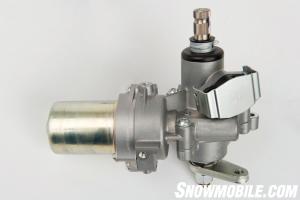 The steering motor relies on various sensors to adjust steering inputs.
The steering motor relies on various sensors to adjust steering inputs.
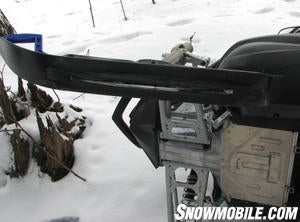 Yamaha’s power-assist ski uses a smoother prow and extra width to reduce “darting.”
Yamaha’s power-assist ski uses a smoother prow and extra width to reduce “darting.”
The third generation Apex front suspension uses a wider but shorter keel ski with smooth prow. The majority of the keel gets moved behind the ski mount location to help reduce on-trail “darting,” where the runner follows pre-existing ski ruts in the trail. The wider design is intended to help keep the ski out of those ruts and runner marks.
Ski “trail-ability” and overall on-trail stability drove the concept as the new ski feels and was designed for more aggressive turn-in at the corners. The new front end adds a stronger, beefier spindle and grease zerks on the A-arms for improved maintenance.
While we sensed something was happening in the steering as we rode, Yamaha confirmed that its power assisted steering (EPS) is speed sensitive, with maximum assist at stop and slow speeds. The EPS uses sensors to read steering torque, vehicle speed, engine speed and the actual current running to the motor. If you test ride a new Apex, you’ll see a special die-cast piece specific for the EPS assembly. The entire EPS addition is said to add about 18-pounds overall, although some other vehicle changes did remove a few pounds elsewhere. Still, with EPS, the added weight becomes somewhat irrelevant.
You’ll find that Yamaha offers a specific suspension depending on the particular Apex model. The base model is designed specifically for a smooth and comfortable on-trail ride and features the Mono-Shock II RA with remote adjustment inside an “open” window 128-inch long Rip Saw track. The Apex SE offers a very comfortable and sporty suspension featuring Fox’ newest design Air shocks on the rear suspension arms. The Apex XTX is the “stretch” track version for occasional off-trail boonie whacking and comes with a 144-inch track spinning around tipped rails that gives the Apex XTX the handling of a short track with the off-trail flotation of a longer track.
Ergo Updates
In addition to the improvements in on-trail power “feel” and steering ease, Yamaha reworked the seat to give you a 2-inch rise at the hips and better positioning behind a totally new and more protective windshield. The seat adds storage space and if you are trailing a new Apex, you’ll see its new LED taillight.
While the sled looks very similar to past Apex models, the 2011 proves deceptive as it comes with a new tunnel that had to be added to fit the EXUP and revised exhaust mounting. This is also where Yamaha cuts a few ounces from its newest Apex.
Since the Apex is THE big news for model year 2011, you will be right in suspecting that the rest of the line remains pretty the same as last season, when the Nytro and mountain sleds enjoyed much that was new. So, look for bodacious color and graphics options and the repackaging of some models.
Total Lineup
In the mountain segment, the second-fastest growth area in snowmobile sales, Yamaha continues with the Nytro MTX SE162, SE 152 and Phazer MTX. The Apex mountain version has been eliminated as the three-cylinder, 130-plus horsepower Genesis triple in the Nytro MTX outperforms it in most situations.
The touring and utility segments remain virtually unchanged. The big unit RS Viking comes with a carbureted 120-hp triple. There’s still the Phazer-based Venture Lite with an 80-hp twin and two versions of the Venture. The Venture GT offers a fuel-injected triple while the base Venture retains the carbureted engine.
The rough trail segment has been rechristened the Cross Country segment and retains the XTX, LTX and Nytro versions from the previous season. The LTX versions offer a 136-inch track. This stretch track grouping includes the Vector LT and Nytro XTX with the 144-inch track length. The “short” track group has been combined into the Nytro FX and Nytro RTX — the SE designation for the Nytro goes away. The Phazer continues with GT and RTX versions.
You’ll also find that Yamaha no longer refers to its engines as “Genesis” whatevers. They are more simpler referred to as Sport Performance — 80-hp twin; High Performance — 130+-hp fuel injected triple; or, Top Performance — 150+-hp fuel injected, four-cylinder. And, then there’s a moderate performance carbureted triple. You figure out the whys and wherefores.
The bottom line for model year 2011 Yamaha revolves around the totally revamped 2011 Apex series — the world’s first power steering snowmobile. But, let’s not forget the totally revamped suspensions, ergonomics, four-cylinder engine and its first-ever “power” valve exhaust system for snowmobiles. Maybe the Apex, at first glance, doesn’t seem all that different, but rest assured that this is a totally new and tremendously more trail-friendly snowmobile that you will have to ride to believe.
Related Reading
Yamaha Unveils Electronic Power Steering
2010 Yamaha Apex GT Review
2010 Yamaha Apex MTX Review
All Things Yamaha on Snowmobile.com



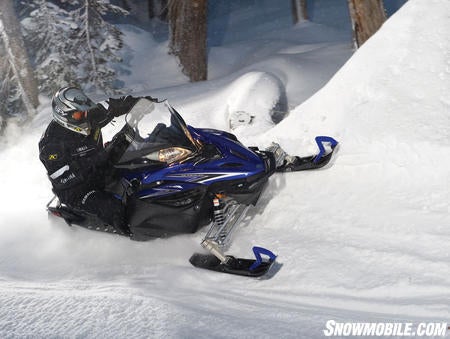
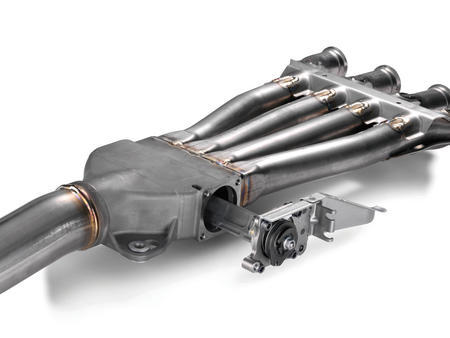
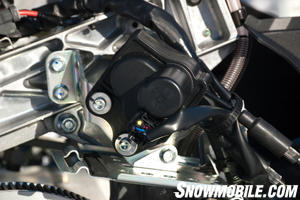
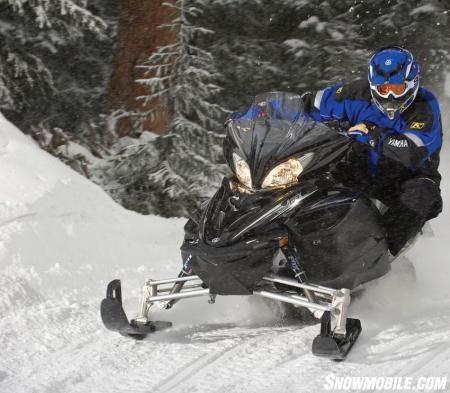
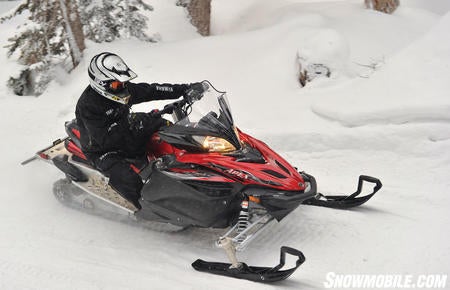
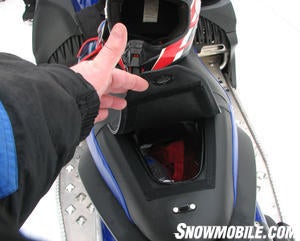
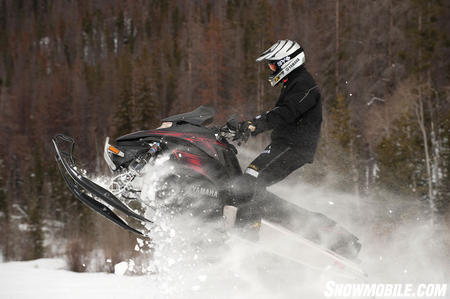
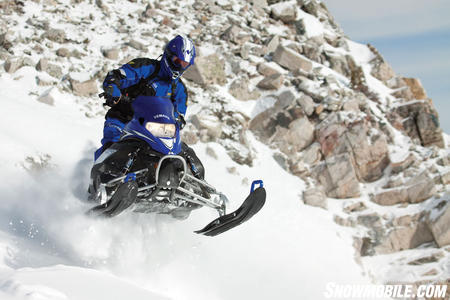


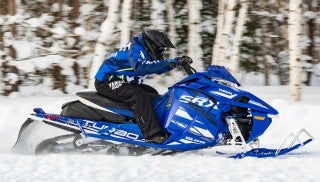


 Your Privacy Choices
Your Privacy Choices